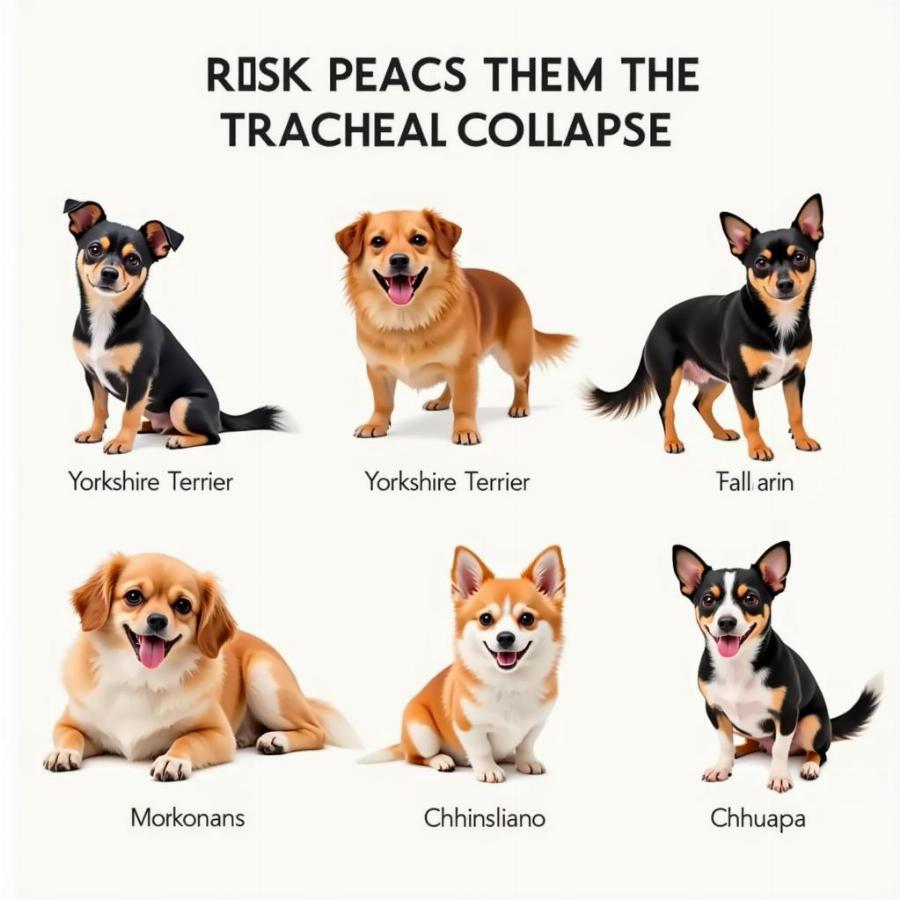Dog tracheal collapse is a progressive, degenerative disease affecting a dog’s trachea, or windpipe. It can be a frightening experience for both dog and owner, especially during coughing fits. While a complete cure is unlikely, dog tracheal collapse home treatment can significantly improve your dog’s quality of life and manage the symptoms. This article will explore various home treatment options, focusing on how to provide the best possible care for your furry friend.
Understanding Dog Tracheal Collapse
Before diving into home treatments, it’s crucial to understand what tracheal collapse is. The trachea is made of C-shaped rings of cartilage that hold it open. In dogs with tracheal collapse, these rings weaken and flatten, causing the trachea to narrow and restrict airflow. This leads to coughing, difficulty breathing, and even cyanosis (bluish gums) in severe cases. Small breeds like Pomeranians, Yorkshire Terriers, and Chihuahuas are particularly prone to this condition. While the exact cause is unknown, genetics, obesity, and respiratory infections are thought to play a role.
Home Treatment Strategies for Tracheal Collapse in Dogs
Managing tracheal collapse often involves a combination of lifestyle changes, medications, and supportive care. While veterinary intervention is essential for diagnosis and prescribing necessary medications, many aspects of care can be implemented at home.
Managing Your Dog’s Environment
One of the most important aspects of dog tracheal collapse home treatment is creating a low-stress, allergen-free environment. Avoid cigarette smoke, dust, pollen, and strong cleaning chemicals, all of which can irritate the trachea. Using a harness instead of a collar can significantly reduce pressure on the trachea and alleviate coughing. Maintaining a healthy weight for your dog is also crucial, as obesity exacerbates breathing difficulties.
Dietary Considerations for Dogs with Tracheal Collapse
Nutrition plays a vital role in managing your dog’s overall health, including their respiratory system. Feeding a balanced, high-quality diet can help maintain a healthy weight and support immune function. Consider smaller, more frequent meals to avoid putting extra strain on the trachea after large meals. Always ensure fresh water is readily available.
Medications and Supplements
Your veterinarian may prescribe medications such as cough suppressants, bronchodilators, and anti-inflammatory drugs to manage your dog’s symptoms. Always follow your veterinarian’s instructions carefully when administering medication. Some owners also find that certain supplements, like glucosamine and chondroitin, may support cartilage health, although further research is needed to confirm their effectiveness.
Recognizing Emergency Situations
While home treatment can be effective in managing tracheal collapse, it’s important to recognize when to seek immediate veterinary attention. If your dog is experiencing severe difficulty breathing, cyanosis, or is showing signs of distress, seek emergency care immediately.
What Causes a Collapsing Trachea in Dogs?
The exact cause of tracheal collapse in dogs remains somewhat of a mystery. However, several factors are believed to contribute to the weakening of the tracheal rings. These include genetic predisposition, as certain breeds are more susceptible. Other potential factors include chronic respiratory infections, obesity, and exposure to irritants like smoke and dust. Understanding these potential causes can help you take preventative measures.
 Dog Breeds Prone to Tracheal Collapse
Dog Breeds Prone to Tracheal Collapse
Can a Dog Fully Recover From Tracheal Collapse?
Unfortunately, tracheal collapse is a progressive disease, meaning it tends to worsen over time. While a full recovery is unlikely, dog tracheal collapse home treatment can significantly improve your dog’s quality of life and manage the symptoms effectively. By following your veterinarian’s recommendations and implementing the strategies discussed here, you can help your furry companion breathe easier and enjoy a more comfortable life. It’s important to remember that consistent care and management are key to providing the best possible outcome for your dog.
Conclusion
Living with tracheal collapse can be challenging for dogs, but with diligent home treatment, you can significantly improve their comfort and quality of life. By understanding the condition, implementing environmental modifications, and working closely with your veterinarian, you can provide the best possible care for your beloved companion. Remember, a proactive approach to managing tracheal collapse is crucial for minimizing symptoms and ensuring your dog lives a happy and fulfilling life.
Frequently Asked Questions (FAQ)
- What are the signs of tracheal collapse in dogs?
- How is tracheal collapse diagnosed?
- What is the life expectancy of a dog with tracheal collapse?
- Are there any surgical options for tracheal collapse?
- What can I do to prevent tracheal collapse in my dog?
- Can cough drops help a dog with tracheal collapse?
- What are the best harnesses for dogs with little brown dogs with tracheal collapse?
Further Reading
Check out these related articles for more information:
- What causes dogs to gag and cough?
- Life expectancy of a pomeranian dog.
- Little brown dogs.
Beaut Dogs is your trusted source for all things canine, providing reliable and expert information on the wonderful world of dogs. From breed characteristics and care guides to health advice and product recommendations, we’re here to help you navigate the joys and challenges of dog ownership. For personalized support and detailed answers to your specific questions, please contact us at Email: [email protected]. We’re committed to providing you with the most accurate and helpful information possible. Visit https://beautdogs.com today to learn more!